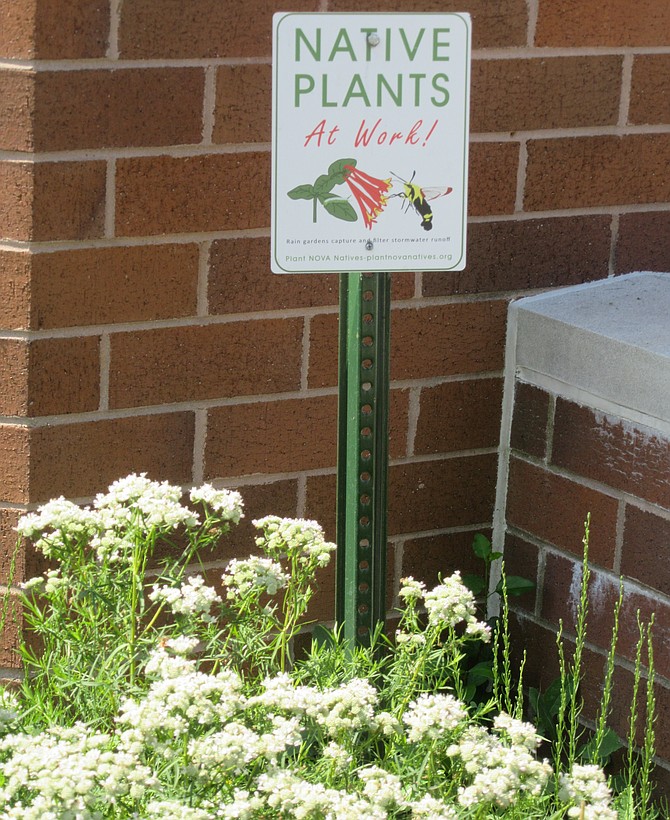Volunteers installed native plants at the Mount Vernon Government Center as part of a natural landscaping project.
On a recent 90-plus-degree sunny day, the narrow-leaf mountain mint outside Supervisor Dan Storck’s window at the Mount Vernon Government Center was literally buzzing. At least 50 bees and a striking common buckeye butterfly were nectaring on the white blossoms.
“These plants are usually covered with native bees, some of which are so tiny you might not notice them,” said Cathy Ledec, Mount Vernonite and county Tree Commission Chair, adding, “This is a fantastic bloomer and the bees and butterflies love it.”
The plant is part of a makeover on the building’s grounds, a project Ledec headed in 2019, to use natural landscaping and install native plants instead of turf grass and non-native ornamental plants typically found outside public buildings.
More county properties could be transformed under a policy adopted by the Fairfax County Board of Supervisors. On June 9, on a vote of 8 to 0, the Board amended the county’s comprehensive plan to apply natural landscaping approaches to county properties. Natural landscaping largely minimizes lawns and uses native plants to restore natural ecological functions like retaining stormwater, cleaning the air and controlling sediment and erosion. Native plants support the native insects and other wildlife with which they co-evolved.
Supervisor Storck, who initiated the amendment in 2018, said, “Natural landscaping practices and materials help to protect and enhance existing natural resources, including soil and water quality, mitigate climate change, improve and preserve air quality and contribute to resource conservation. The Mount Vernon Governmental Center is one example of the use of natural landscaping to improve County properties.”
Calling it a “holistic approach,” Chairman Jeff McKay agreed: “Each site has a role to play in the creation of a healthy environment for both people and wildlife. Both the aesthetic and ecological functions of landscaping throughout built and natural environments should be considered. By prioritizing native plants, healthy soils, improving biodiversity and minimizing the disturbance of natural habitats at our County facilities, we are working to ensure a resilient and healthier environment.”
“Natural landscaping supports the wellbeing of county employees. Members of the public who walk through wooded areas and natural landscapes on their way to meetings will arrive less angry, anxious, depressed, confused and fatigued than they do now.”
—Elizabeth Martin
At a May 14 Planning Commission hearing and the June 9 Board hearing, supporters urged officials to adopt natural landscaping as formal policy in the comprehensive plan, the official guide to land use decision-making. Eight speakers argued that natural landscaping can reduce pollution and noise from mowers, reduce heat around buildings and paved areas and save money long-term once plants are established.
Stratford Landing resident Elizabeth Martin stressed that being out in nature "significantly decreases anxiety, depression, anger, confusion and fatigue. Natural landscaping supports the wellbeing of county employees. Members of the public who walk through wooded areas and natural landscapes on their way to meetings will arrive less angry, anxious, depressed, confused and fatigued than they do now."
Margaret Fisher of the Plant NOVA Natives campaign cited the decline in undisturbed land in the county, and offered, “It is a delight to know that Fairfax County will be leading this movement, demonstrating how beautiful and practical it is to create an environment where humans and non-humans can thrive together in our shared ecosystem.”
No opponents spoke at either hearing.
The county has used this approach at several Mount Vernon sites, including West Potomac High School, Martha Washington Library and Gilbert McCutcheon Park. The Mount Vernon Government Center project included the county's Facilities Management Division, Fairfax Master Naturalists, Audubon Society of Northern Virginia's Audubon-At-Home program, the Northern Virginia Soil and Water Conservation District and Earth Sangha.
Calling for more local action, University of Delaware entomologist Douglas Tallamy argues that national parks and conservation preserves in isolated patches cannot alone curtail species losses or restore ecological health. With this policy implemented, Fairfax County can be a leader and example, say proponents.

